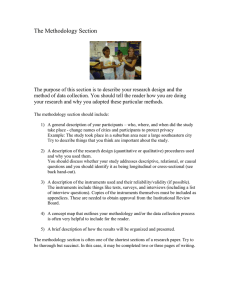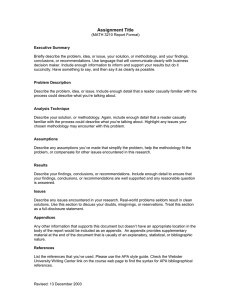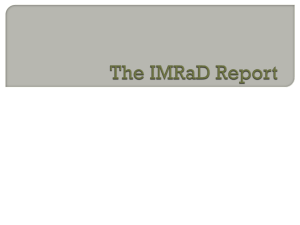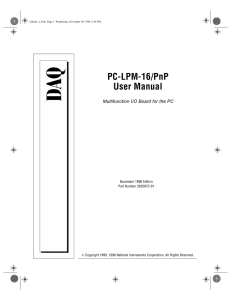Dr. Marshall’s Handy-Dandy Outline for the Research Prospectus Ed Admin 615B
advertisement
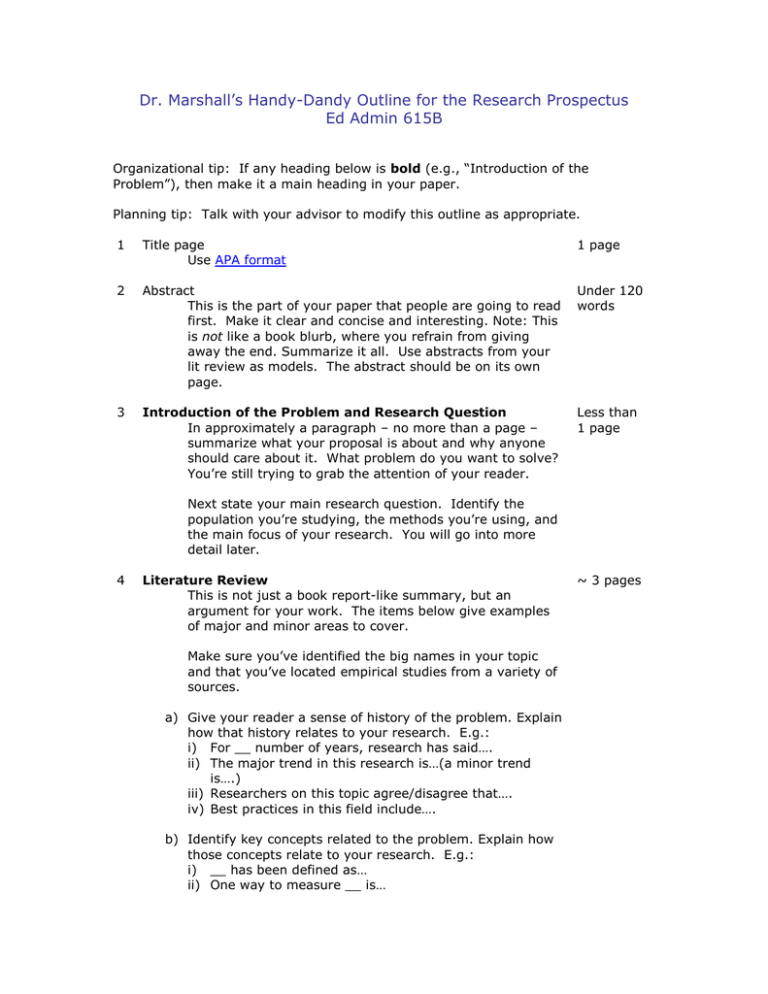
Dr. Marshall’s Handy-Dandy Outline for the Research Prospectus Ed Admin 615B Organizational tip: If any heading below is bold (e.g., “Introduction of the Problem”), then make it a main heading in your paper. Planning tip: Talk with your advisor to modify this outline as appropriate. 1 Title page Use APA format 1 page 2 Abstract This is the part of your paper that people are going to read first. Make it clear and concise and interesting. Note: This is not like a book blurb, where you refrain from giving away the end. Summarize it all. Use abstracts from your lit review as models. The abstract should be on its own page. Under 120 words 3 Introduction of the Problem and Research Question In approximately a paragraph – no more than a page – summarize what your proposal is about and why anyone should care about it. What problem do you want to solve? You’re still trying to grab the attention of your reader. Less than 1 page Next state your main research question. Identify the population you’re studying, the methods you’re using, and the main focus of your research. You will go into more detail later. 4 Literature Review This is not just a book report-like summary, but an argument for your work. The items below give examples of major and minor areas to cover. Make sure you’ve identified the big names in your topic and that you’ve located empirical studies from a variety of sources. a) Give your reader a sense of history of the problem. Explain how that history relates to your research. E.g.: i) For __ number of years, research has said…. ii) The major trend in this research is…(a minor trend is….) iii) Researchers on this topic agree/disagree that…. iv) Best practices in this field include…. b) Identify key concepts related to the problem. Explain how those concepts relate to your research. E.g.: i) __ has been defined as… ii) One way to measure __ is… ~ 3 pages Marshall — 2 iii) The way in which ___ gets enacted most often is…. c) Identify any theory which underpins your research and build a conceptual framework. E.g.: i) This research stems from the field of anthropology, which provides it with… ii) This research builds upon critical race theory, which states…. d) Explain how your research is different than the field so far. i) This research includes different populations, methods, concepts, ways of approaching the question… ii) However, my research…. e) Explain what your research contributes to the field. Make sure all your literature relates to your research questions. If your RQs do not mention school culture, then do not mention it in your literature review. You do not have to cover the entire history of education here; just the bits that are relevant to your work. 5 Research Questions (RQs) Tying in to the literature you just reviewed, restate your big research question and all its sub-questions ~ 2 pages a) Identify hypotheses for each question b) Identify working assumptions for each question (again, based on the literature) c) If you include a Maxwelli matrix, put it in an appendix. 6 Significance of Proposed Study Remind your reader again why your research is new and useful. ~ 1/2 page 7 Design and Methodology Because this section is so long, sprinkle in level 2 subheadings as you see appropriate. You might look at other research papers for ideas. 10+ pages a) Qualitative or Quantitative or Mixed? (MS ii p. 438 ff) i) Briefly describe what general kind of methodology you are using and why (should link back to literature review in some way). ii) What type of research design are you using? (e.g., experimental, case study) and why? iii) Briefly describe what conclusions or types of conclusions are possible. Ideally this step will prevent your paper from being inconclusive. E.g. “If we find data of this flavor, we’ll know X. If we find data of this other flavor, we’ll know Y. If only half the subjects return their surveys, we’ll still know at least Z.” Marshall — 3 b) Selection of sample (MS p. 402) i) Whom are you choosing to study and how did you choose them? ii) How did you get access to this site or data? iii) Use a table to describe how many people you are talking about, particularly if they come from different groups: e.g., 10 teachers, 3 schools = 30 people iv) What is your comparison group? What are their important similarities to and differences from your target population? c) Instruments and Procedures i) Describe surveys, interview protocols, etc. Put the actual instruments in an appendix. ii) Describe the pilot study you used to test your instrument or other ways in which you or others have tried to validate it or make it reliable. If you want to include pilot data or other details, put them in an appendix, but write about what you have learned from the pilot (process, findings) in the proposal itself. iii) In a table, describe your data collection plan. Explain when and how often you are using the instruments: E.g., surveying entire school in the spring and fall using the XYZ survey developed by __ & ___, also interviewing the principal at least three times over the school year, etc. Be specific! E.g., Are you audiotaping interviews? How long will they last? Are you transcribing them? Entering them into a software program? d) Analysis of Data i) What statistical or coding techniques are you using to mine your data? (reading data repeatedly? Hierarchical Linear Modeling?) ii) Are you using particular software? iii) Have other people used this technique? (refer to lit review again) e) Limitations Here you acknowledge any limitations of your research or any risks that might challenge its validity. i) Researcher role (1) How are you part of this research situation? (2) How “objective” do you think you are? Address the participant-observer continuum. (3) What are your biases and assumptions and how are you going to control for them? ii) Ethics (1) What ethical decisions have you already made or do you anticipate making? (e.g., what will you do about negative findings?) Marshall — 4 (2) How will you ensure that your research participants come to no harm? (3) Do you have IRB approval yet? iii) Validity (1) How have you tried to ensure that your study actually answers your question? (2) What alternative explanations could account for any of your findings? (3) How generalizable is your study to other demographics, other contexts, other countries? 8 9 10 11 12 Conclusion Wind up with a strong paragraph or two explaining that despite aforementioned limitations, your work is going to be as methodologically rigorous as possible. Then remind your reader of its significance again. Timeline Outline your workplan, including, submitting IRB application, collecting data, analyzing data, getting a draft to your advisor, getting a draft to your POS committee, revising, and presenting at your oral exam. Budget Include research expenses, potential funding sources. References Use APA format. List only references that you cite, not everything you read. ~ 1 page ~ 1 page Appendices a) Consent Form b) Instruments / Protocols c) Supporting data, if any Maxwell, J. A. (2005). Qualitative research design: An interactive approach (2nd ed.). Thousand Oaks, CA: Sage. ii McMillan, J. H., & Schumacher, S. (2001). Research in education: A conceptual introduction (5th ed.). New York: Addison Wesley. i
